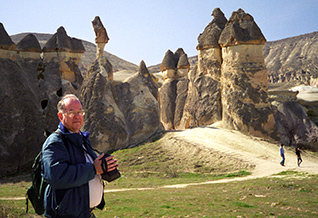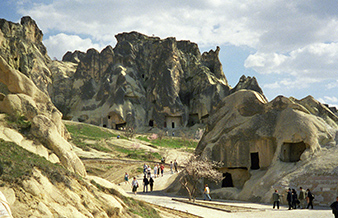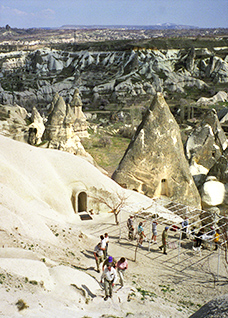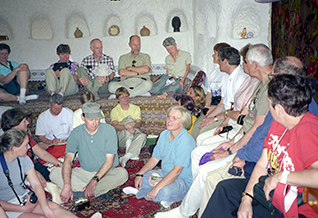Western Turkey
Day 8 - Wednesday, 8 April 1998
When the morning sunlight pried our reluctant eyes open, we gazed in wonder at the astonishing rock formations just outside. We were in a strange land formed by deep layers of volcanic ash, compressed into a form of rock called tuff with the surface eroded into fantastic shapes called "fairy chimneys." For the next two days we had the opportunity to walk among the formations, and explore the now abandoned 'carved into the rock" homes. These were lived in as recently as 1952, when the government forced their evacuation.

This wide valley is honeycombed with such dwelling places. There are monasteries, churches, homes, and mills where the rock is carved just enough to leave rom for the donkey's bellies.
Throughout the area, Meli pointed us to the evidence of self-sufficiency. She reminded us of her lecture on the three types of people in Turkey, saying, "Environment affects character. Self-sufficiency creates self-confidence. The people in Cappadocia were able to carve their homes into the tuff. They could also pound it into fine particles and plant in it. Pounding it even more made it into an excellent paving material. It is the planting material that is most interesting in this remote area.
The grapevines here are very small, close to the ground and not trellised at all. But the tuff that is broken down into dust is swept up into hillocks to provide growing space for the roots. Each year the old vines are pruned and the "dirt" (the crumbled tuff) is mounded up around the plants again. The vine prunings provide material for kitchen fires, along with dried dung from the livestock.
In addition to the goats and cows that they kept, pigeons were very important to these rock dwellers. Not only did pigeons provide a source of protein in their meat and eggs, but also their droppings were a very important source of fertilizer for the crops. So beside the homes for people carved into the tuff, there were pigeonholes as well. Elaborate designs were painted around the holes as the people competed with each other in their efforts to attract pigeons.

Goreme
In the open-air museum of Goreme, we visited several old churches. Some are named because of what is painted on the walls. The Elmali (apple) church is called that because Jesus is depicted holding a round object. Some have suggested that it is symbolic of the world, but the name apple is still used. The Yilanli (snake) church is called that because of the paintings that show the struggle of St. George and St. Theodore with a snake. Later research indicates that this is the same St. George we saw in England fighting a dragon.
The Barbara church has a painting of St. Barbara in it, but also something quite strange that looks a bit like a cockroach standing on his hind legs. No explanation is given for this picture. In one of the churches wheat and grapevines are painted. This seemed mysterious to Meli, even though she knows about the bread and wine. She wondered why the vines themselves would be depicted, rather than just the grapes and the wine. A couple of the tour members were able to tell her about Jesus' teaching of Himself as the vine, and believers as the branches.
In the book of John, chapter 15, these verses answer her question: I am the vine, ye are the branches: He that abideth in me, and I in him, the same bringeth forth much fruit: for without me ye can do nothing. If a man abide not in me, he is cast forth as a branch, and is withered; and men gather them, and cast them into the fire, and they are burned. The pruned vines in the fields outside, and our knowledge of the fact that the people here use the cut branches as firewood, lends new life to this scripture, for Meli and for us.

"Rock" house
A very delightful event on our tour was the opportunity to visit with some of Meli's friends who live in a rock house. She told us the story of how she met these lovely people. She had a tour that was causing her much grief; she seemed unable to please them. So at this location, she left them alone on the cliff to survey the wondrous valley below, and wandered away by herself. Coming upon the friendly family, she poured out her heart to them. A friendship was quickly established with these generous and welcoming people, and their home has become a regular stop on Meli's tours.
We were served apple tea, and given a tour of the home. City water, electricity and gas are piped in and the house is connected to the city sewer. The décor is as lovely as any home could be. Carpets are used as wall hangings, or to cover a cupboard carved into the wall, as well as for floor coverings. Kilims drape the cushioned U-shaped, tuff-carved bench that wrapped around three sides of the family room. A bedroom that we were allowed to visit had a window on the right overlooking the valley, and a niche on the opposite wall (on the left) that serves as an indoor garden. A bed is carved into the wall at the far end of the room, and looks like any bed with pillows and bed coverings. It has a feeling of being a special retreat.

The mother of the home has been persuaded by Meli to display her needlework, and the women have a shopping opportunity for handmade dolls, scarves and crocheted doilies. The father has retreated to the courtyard in front of the home, and is sitting underneath his grapevine. This vine is on a trellis and will provide shade from the summer sun. We are too early in the season, and the leaves are not out yet, so it is still bare vine.
Next was a tour and demonstration of a rather large carpet shop where we learned that women can make cotton and woolen carpets, but only young girls have hands small enough to knot the silk carpets. A demonstration of silk, from the cocoons dropped in hot water to kill the worm and release the fibers, to the dancing movements of the spinner who dashed back and forth across the room to make a silken thread, fascinated us. A lecture on the dye process helped us to understand natural dyes. Indigo was most amazing. The yarn came out of the dye bucket green, and before our eyes it turned bright blue, transformed by oxidation.
Many people were persuaded to buy one of the beautiful carpets. Dazzled by the colors, the patterns, the textures, the customer chooses by the process of elimination. "Take away the one you like least." At the end, our choice came down to two carpets, a hall runner in red, or a 4 x 6 in shades of blue. The final decision was based on the fact that a hall runner could just be laid down and enjoyed, but a living-room carpet might demand a change in more things than just a rearrangement of furniture. (When the carpet arrived, it was more dark blue and less red than we remembered. We laid it in the living room after all, because the light is better there than in the hallway.)